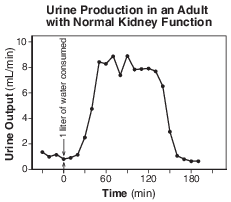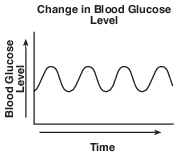Topic: Stimuli And Feedback
Stimuli And Feedback
When the human body is responding to stress, the hormone adrenaline is released. A short time later, the body returns to normal. This is an example of how a human
(1) reacts to an antibody
(2) develops genetic variation in body cells
(3) maintains cellular organization
(4) maintains dynamic equilibrium
Like humans, animals including dogs and cats get goose bumps. On a cold day, these goose bumps cause their coats to expand creating a layer of insulation. If the animal is scared, the coat will also expand making the animal look larger to predators. These responses serve as examples of
(1) allergic reactions
(2) learned behaviors
(3) detection and response to stimuli
(4) reproductive and feeding success
Which change is an example of a response to a stimulus?
(1) The pupil of an eye decreases in size in bright light.
(2) A leaf absorbs sunlight in the morning.
(3) The water level of a pond rises on a rainy day.
(4) A dead tree decays after many years.
A small lizard spends the morning hours lying in the sunlight until its body temperature rises. Later on in the day, the lizard rests in a shady area until its body temperature cools. This type of behavior is important to
(1) maintain homeostasis
(2) detect variations
(3) attract mates
(4) obtain nutrients
The diagram below represents changes that take place within the human body.

The diagram represents
(1) cellular differentiation
(2) dynamic equilibrium
(3) gene interaction
(4) biological evolution
The diagram below represents an activity that occurs in the human body.

This diagram best illustrates
(1) active transport
(2) maintenance of homeostasis
(3) synthesis of nutrients
(4) differentiation
Riding a bicycle requires balance and constant adjustment and monitoring by the rider in order to continue cycling. Successfully riding a bicycle most directly results from the ability to
(1) sexually reproduce
(2) grow and develop
(3) detect and respond to change
(4) metabolize food for energy
When an ant in a colony dies, the live ants will throw the dead ant out of the anthill. If a live ant from the colony, ant X, is sprayed with a chemi- cal characteristic of dead ants, the live ants will repeatedly throw this ant out of the anthill until they can no longer detect the chemical on ant X. What is the best explanation for this behavior?
(1) The ants are responding to a chromosomal mutation in ant X.
(2) The chemical is exhibiting a feedback mech- anism.
(3) The live ants must continue this behavior until they have eliminated ant X.
(4) The chemical acts as a stimulus for a partic- ular behavior.
An investigation was carried out to determine the effect of drinking an excessive amount of water on urine flow. A subject drank 1 liter of water in 5 minutes, and then urine output was measured. The graph shows how the human adult kidneys responded to regulate water balance in the body. Urine output was measured every 10 minutes for a little over 3 hours. Normal output for an average adult is approximately 0.5–1 mL/min.

One half-hour after the liter of water was consumed, the urine produced by the kidneys was
(1) between 2 and 3 mL/min
(2) between 4 and 5 mL/min
(3) eight times greater than normal
(4) below the normal range
Breathing rate is constantly being monitored and adjusted in the human body, which results in
(1) the differentiation of mature body cells
(2) feedback mechanisms removing damaged cells
(3) modification of gene activity in cells
(4) the internal environment being kept within certain limits
A substance directly involved in cellular commun- ication within the human body is
(1) an antibody
(2) an antibiotic
(3) a hormone
(4) a starch
The graph below shows changes in the level of glucose in the blood of a person over a period of time.

The graph represents the
(1) maintenance of dynamic equilibrium
(2) failure of homeostasis
(3) reaction of white blood cells to a pathogen
(4) oxygen carrying capacity of the blood
A person usually experiences small variations in body temperature over a 24-hour period. These variations in temperature are an example of
(1) an immune response
(2) genetic differences between individuals
(3) an adaptation to global warming
(4) dynamic equilibrium
Feedback mechanisms have evolved that maintain homeostasis. Describe how homeostasis is maintained through feedback. In your answer, be sure to:
• identify one feedback mechanism in the human body [1]
• identify, other than death, one specific result if homeostasis fails in the human body [1]
• describe how a plant regulates water loss through a feedback mechanism that involves guard cells [1]
The student’s response to the bulleted items in the question need not appear in the following order.
• 14 Allow 1 credit for identifying one feedback mechanism in the human body. Acceptable responses
• include, but are not limited to:
• — the change in heart rate in response to exercise
• — the change in respiratory rate in response to exercise
• — sweating or shivering in response to changes in body temperature
• — the maintenance of blood sugar levels
• — regulation of body temperature on a hot day
• — increase in white blood cells in response to an infection
• 15 Allow 1 credit for identifying, other than death, one specific result if homeostasis fails in the human
• body. Acceptable responses include, but are not limited to:
• — disease/gets sick
• — disruption in the body’s ability to carry out respiration/digestion/excretion, etc.
• — The body is unable to respond to external/internal stimuli correctly.
• — diabetes
• — heat stroke/hypothermia
• Note: Do not allow credit for death.
• 16 Allow 1 credit for describing how a plant regulates water loss through a feedback mechanism that
• involves guard cells. Acceptable responses include, but are not limited to:
• — Guard cells close openings in the leaves, slowing/stopping water loss.
• — When guard cells close the stomata, less water evaporates out of the leaves.
• — Guard cells regulate the rate of transpiration when they change shape.
Blood Doping
Blood is a fluid tissue, which means that blood cells are suspended in a fluid called plasma. Blood tests are concerned with not only the number of blood cells present, but with the amount of plasma that surrounds the cells.
The diagram below represents tubes containing blood samples from an athlete before and after blood doping. Blood doping is an illegal practice reportedly used by some athletes a few weeks before an athletic event, and involves removing whole blood from an athlete, separating the oxygen-carrying red blood cells (RBCs), and then freezing them. These RBCs are thawed and returned to the athlete’s body just before the athlete competes. Serious health risks are associated with this practice.

More middle- and long-distance runners have tested positive for blood doping than short-distance runners, such as sprinters. State one reason why athletes participating in certain events might be more likely to practice blood doping than others. [1]
Allow 1 credit. Acceptable responses include, but are not limited to:
• — Short distance runners don’t run as long.
• — Some athletic events require oxygen for increased respiration for a longer time. Extra RBCs
• would provide an advantage.
• — Long-distance runners need increased oxygen for a longer time than sprinters.
